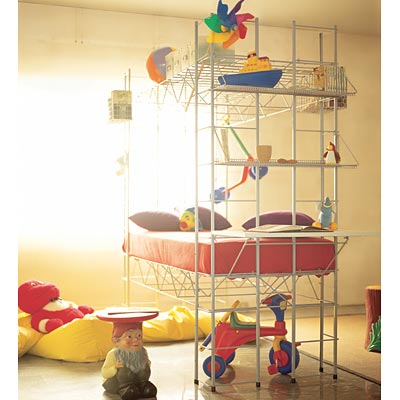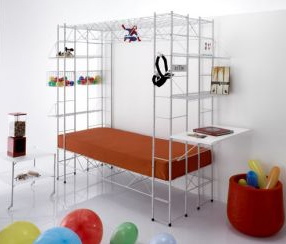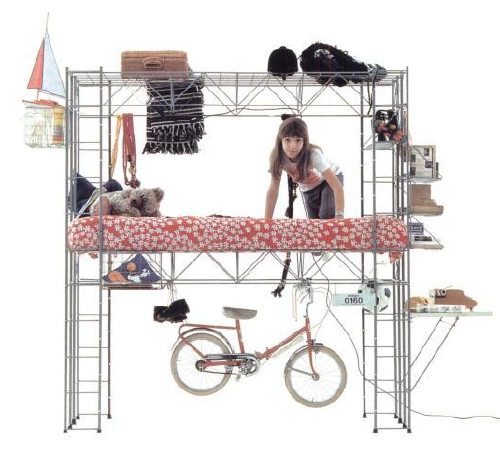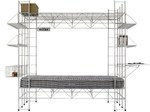
It's not nearly enough to know that "abitacolo" is where the pilot sits on a plane, or where the humans ride in a car. No, to Bruno Munari, the Abitacolo he designed in 1971 for the Italian furniture company Robots is much, much more.
Abitacolo was a modular fixture for a kid's room that combined storage, play, writing, and sleeping in one reconfigurable wire-frame package. Despite the presence of a near-identical idea for multipurpose living structures, Munari wasn't mentioned in either of Hennessey and Papanek's Nomadic Furniture books. And though his goal was more DIY than BUY, Ken Isaacs didn't mention it in his 1974 classic, How To Build Your Own Living Structures, either. Still, the Abitacolo was winning awards in 1979, and as far as I can tell, it stayed in production for a while after that.

The Abitacolo's extremely utilitarian design actually looks better full, not empty. The promotional shot [above] with Spiderman and Zizi The Munari-Designed Rubber Toy Monkey, hanging off it is great. But my favorite picture of an Abitacolo in use is a cluttered changing table titled, "Munari secondo noi/ Our second Munari."
The flexible functionality also means that Abitacoli are probably rarely thrown out; they're just moved into the closet or the garage. [If anyone has price or availability info on Abitacoli, new or old, definitely pass it on.]
For sheer poetry, nothing tops Munari's own sales pitch for the Abitacolo, which actually uses the phrase, "a placenta of plastic-coated steel." An ode from The Father of Italian Design to The Mother of All Container Store Products, as reprinted in the catalogue for the Zurich Museum of Design's 1995 Munari exhibition, Air Made Visible, after the jump:

Abitacolobuy Air Made Visible: A Visual Reader on Bruno Munari from Amazon [amazon]Two meters high
It's made of steel with an epoxy skin
It's a structure reduced to the essentials
A space delimited and yet open
Adaptable to one or two people
It can even hold twenty
Although this is not recommended because
of the difficulty of moving
It weights fifty-one kilos
It's two meters wide by eighty centimeters
It's a large object that casts no shadow [ed note: ummm...]
It's an inhabitable module
It's a habitat
It contains all personal things
It's a container of microcosms
It's a placenta of plastic-coated steel
A place to meditate
And at the same time
A place for listening to music that you like
A place to read and study
A place to receive visitors
A place to sleep
A lair, light and transparent
Or closed
A space hidden in the midst of people
A real space
your presence renders furnishings superfluous
Dust doesn't know where to settle
It's the minimum but gives the maximum
Numbered but unlimited
Habitat is the environment
Adaptable to the personality of the inhabitant
At every moment transformable-Bruno Munari, Codice ovvio (1971)
[images via Robots.it; shift.jp.org (via Andy's post on a Munari bedtime book); paolomazzo's flickr stream; Air Made Visible]





This is so so awesome, I'm filing a mental note to try and get this setup for when the kid hits the right age!! If the original isn't readily available, it also (to me at least) screams for an ikea hack - I see some stolmen poles, a custom mattress possibly....